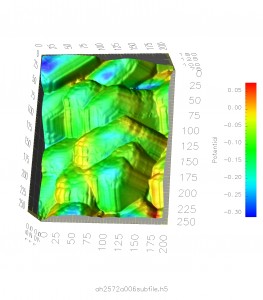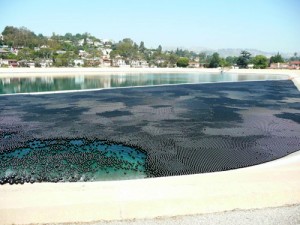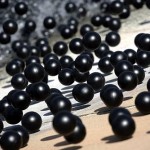Those of you who know the Rockett group well, have likely seen this video. It’s completely hilarious. Anyone who’s ever been in Graduate School will love it…
Work
Funny Chemistry PSA…
Here’s a great Chemistry PSA that reminds me of a teacher I had at Grand River Collegiate Institute in Ontario. I’ll have to dig up his name. He described all the different types of bonding pretty much in terms of relationships. It was simplistic but genius. If I remember his name, or dig out the old year book, I’ll update this post with it.
For now, the hat-tip goes to Dr. Mike at Getting Things Done In Academia.
QCad- Build failed, OsX 10.4.7, Fink, QT3Mac and patched
A very quick one for today. I’ve recently attempted a compile of the open-source program QCad (Community Edition). Unfortunately, even with QT3Mac installed (via Fink) and a patch applied, QCAD is still not compiling under 10.4.7.
I was hoping to use it to edit and draw CAD files for the machine-shop. I may have to use the 10minute demos of the professional version to get the job done quickly. Sad, as I was really looking forward to a good open-sourced CAD software package. I use it infrequently, and definitely don’t need AutoCad.
Here’s the error I recently received. [Will edit this post with more info as I get it...]
main.cpp: In function `int main(int, char**)':
main.cpp:233: error: parse error before `(' token
make[1]: *** [obj/main.o] Error 1
make: *** [qcad] Error 2
Building qcad binary failed
Data Visualization Meets Music Video…
One of the things that makes a Scientist good at what he does (and sometimes gets him serious accolades) is effective communication and visualization of his data, results, and concepts. This is helpful for everyone from the business researcher to the teaching professor (to the graduate-student).
(You’ll never guess where this discussion is going, so click on through to read more and be surprised…)
Read More
Quick One: UIUC Thesis Class Breaks ChapterBib (LaTeX)
I could not decide exactly how to post this… searching high and low, I couldn’t find the answer to my problem. I felt, in the very least, it needed to be posted here. So, I’ve decided to focus on the problem only. Then, in a future post, I’ll describe in more detail how I go about doing my research writing using LaTeX [wikipedia]. So, my basic comment is: I write in LaTeX, BibTeX, etc., and the following will help only a few people doing the same, and doesn’t actually offer a solution right now. ![]() [Boy, aren't I helpful?] (click through to read more…)
[Boy, aren't I helpful?] (click through to read more…)
World’s Largest Materials Science Demo?
For the Materials Scientist, a very interesting event happened on Monday 6/9/08. The Los Angeles department of water and power inadvertantly may have created the largest Materials Science demo of crystal stacking, defects, and boundaries when they placed 400,000 balls onto the surface of the Ivan Hoe Reservoir. [Read the original news release (including video) by the LA Times (images from LA Times) or the blog post at Design Verb where I found out about it.]
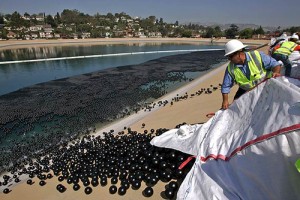
The balls are being placed on the surface of the lake in order to prevent the formation of various forms of bromates [wikipedia]. The bromates are forming due to the presence of both chlorine and bromine in the water coupled with the presence of sunlight. Local public officials hope that the balls will help block sunlight from the lake-water and prevent the bromate formation. [Let's hope that heat doesn't form it either- those balls are going to get really hot with the sun blaring down on them!]
The balls on the surface of the lake is almost exactly like a model often used as a class-room demo called a “Bubble Raft” [wikipedia]. The model describes in 2 dimensions (usually) the concepts of crystallites (polycrystals), grain boundaries, and dislocations. The more common demonstration is table-top consisting of a large number of bubbles on the surface of a thick liquid like glycerin.
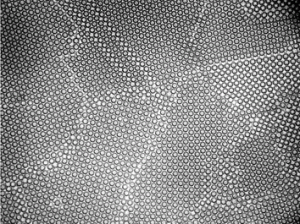
There are even published articles utilizing this approach as a model system for indentation measurements etc. Other common places to see this phenomonon is when you get a pop from the machine (clear-plastic bottle), you may see bubbles form various areas of ordered stacking. Of course, the structure of the pop-bottle bubble raft is quite complex- stacking faults and dislocations abound.
If you look closely at the above image, you’ll notice that there are a number of areas where the balls are all stacked nicely in 2D, and then a little further away, a different orientation of stacking… when these two meet, there’s a “grain boundary”[wikipedia]. In fact, this is exactly what a polished and etched sample of polycrystalline metal looks like in a reflected light microscope. Of course, in a sample like that, you can’t see the atoms at all, but just regions of different reflectivity. (See how the lightness/darkness of the “crystallites” are different?) Little lines in the microscope show the boundaries (often acid etching is required to see them). Of course, if you have a transmission electron microscope (TEM), for instance, you actually *can* see stacks of atoms and grain-boundaries! [There is a world-class Aberration Correction TEM available at the FS-MRL where I currently do research. Hopefully I'll be able to use it to get some excellent images to share.]
Frequently in Science we find beauty in the things around us. Along with all this beauty is some natural function or rule, often unique and interesting. All you have to do is keep your eyes open, walk a bit slower, and enjoy the walk (or bounce as the case may be)!
Published in the Journal of Applied Physics…
Well, I’m finally published in my current field. It took a very very long time to get this paper published. All sorts of reasons for the delay. In fact, this work was originally started in 2004 (our first bicrystal was successfully grown in ’04). During research group meeting, I made an under the breath comment something akin to: “Well, darnit, it’s too bad we can’t study a single grain-boundary, because then everything would be so much easier…” Prof. Rockett looked over to me and smiled: “But, Allen, we can study a single grain-boundary! That’s a great idea!” So, the bicrystal project was started.
We were able to obtain a bicrystal GaAs wafer from Wafer Technology Limited Co. (UK); I requested a bad growth, with crystallites as large as possible. I’ll be forever indebted to the great guys at Wafer Technology for their quick grasp of what I was looking for. After visiting our group in 2006, S. Seibentritt at HMI (now at Lüxenbourg) started similar work.
While this current paper isn’t perfect, it went through numerous revisions. Most of the extensive EBSD calculations didn’t make the paper. Subsequent papers will likely revisit the disorientation discussion.
J. Appl. Phys. 103, 083540 (7 pages) (2008)
http://link.aip.org/link/?JAPIAU/103/083540/1
Unfortunately, there was an error we missed in the proof. The paper is currently missing Figure 2(c): The cross-sectional HRTEM image (the hard work of C. Lei). The image can be found here: Cross-Sectional HREM image of Cu(In,Ga)Se2 bicrystal, hosted at Prof. Angus Rockett’s research group’s webpage.
